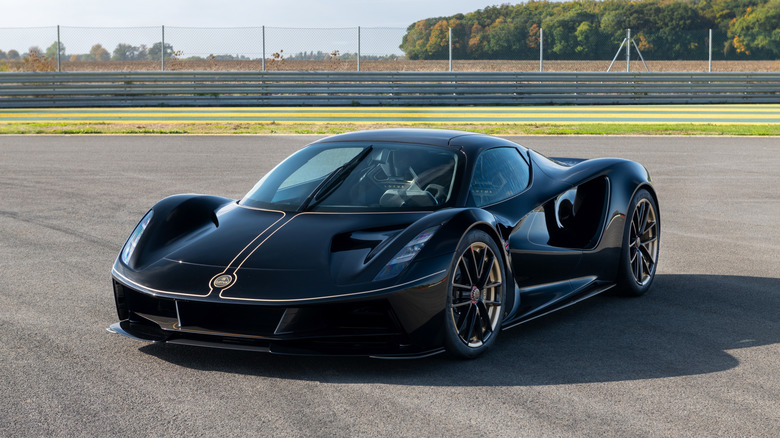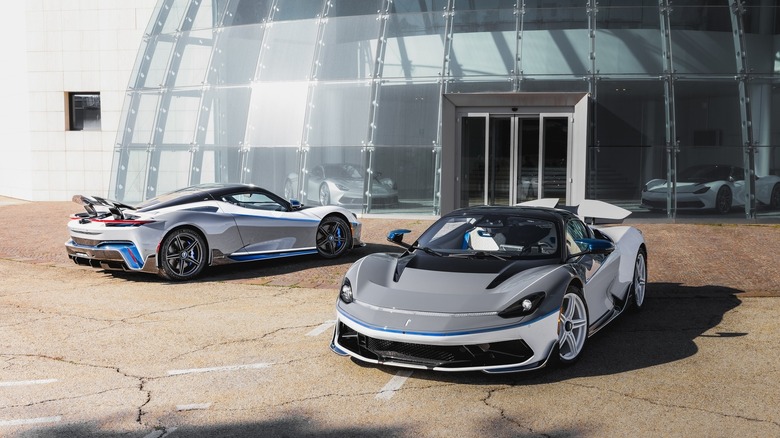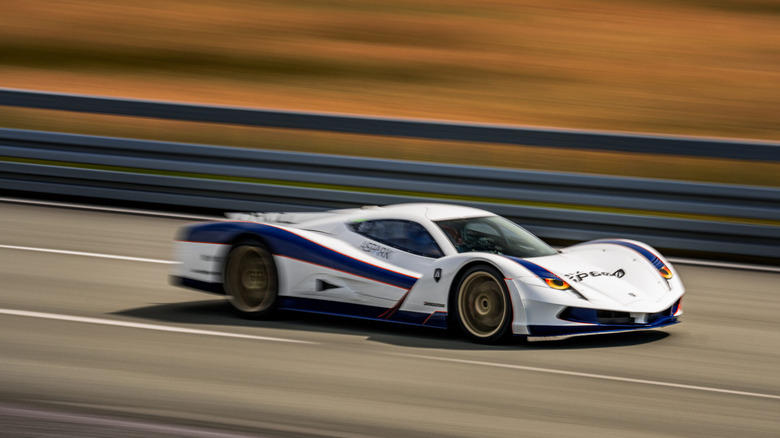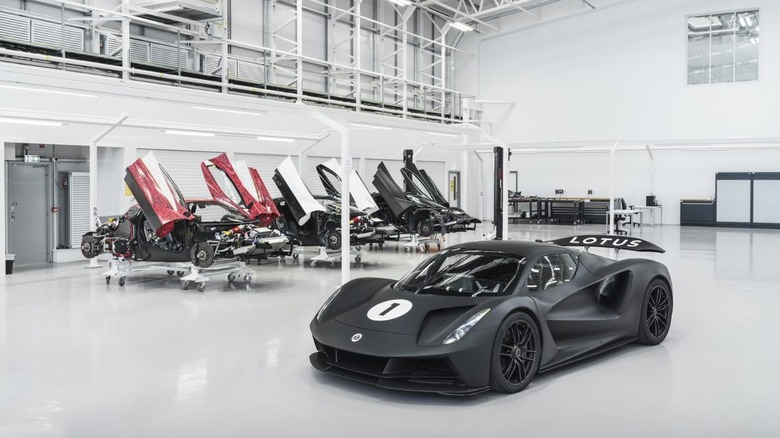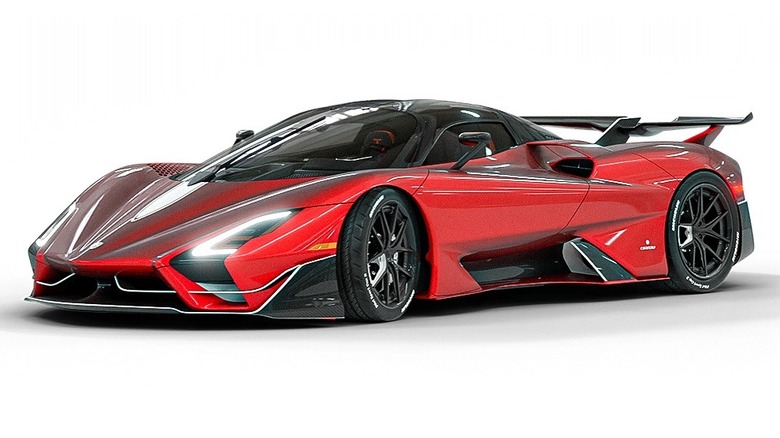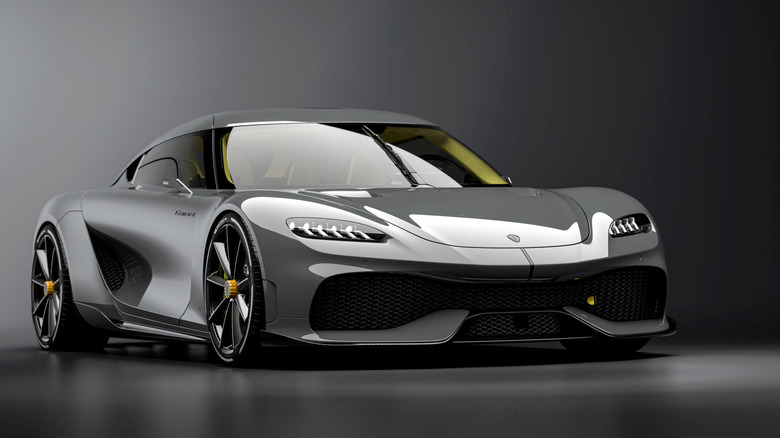5 Hypercars With The Most Horsepower
There is absolutely nothing more extreme in the automotive world than a hypercar. These limited-production monsters of the road produce truly awe-inspiring figures, from 300+ mph top speeds to extraordinarily rare production numbers, and they almost always command prices in the seven-figure range (if they're for sale at all). But which hypercars have the most horsepower?
It's a number which commands a certain level of prestige, though certainly not as much as it commands absolute respect. All of these cars feature well over 1,000 horsepower, and that much energy spinning the wheels is as obscene as it is alien to most of us. Gone are the days when the McLaren F1's 627-horsepower V12 was considered the absolute bleeding-edge of road car technology. Even something as potent as that seems dull when you look at the hard figures — though there's certainly nothing "dull" about a McLaren F1. Still, technology waits for no one, and the further we push the boundaries of road car engineering, the more power we'll extract.
This list represents the current pinnacle of this technology, as of May 2025. Who knows where we'll be in just a few years' time. Consider that, at one point, the classic Porsche 930 Turbo — also deemed the Widowmaker — was among the fastest cars in the world. One decade later saw the release of the McLaren F1, then the Bugatti Veyron, Koenigsegg One:1, and many other outstanding feats of automotive excellence. That said, this list only accounts for production models, not prototypes or failed designs like the infamous Devel Sixteen.
Pininfarina Battista: 1,900 horsepower
You know this list features cars above and beyond the realm of normalcy when even Bugatti's hottest entry doesn't crack the top five. In its stead, meet the Pininfarina Battista, quite possibly one of the most beautiful hypercars ever sculpted. Named after famed coachworks designer and Automotive Hall of Fame inductee Battista Pininfarina, this car's bodywork is certainly the most subtle and restrained on this list, though that's certainly not to the machine's detriment. Underneath that pristine exterior rests four motors powering each individual corner to the tune of 1,900 horsepower with the "Furiosa" mode active. The company website simply lists the top speed as somewhere over 217 mph (that's likely a conservative estimate), and it reaches 60 in just 1.86 seconds.
To put these numbers in comparison, think of a Tesla Model S Plaid. That's a production car which is particularly famous for its 1,020 peak horsepower rating, propelling it to 60 mph in 2.28 seconds without the rollout, according to Motor Trend's testing. Meanwhile, the Pininfarina — the lowest-ranked car on this list — boasts almost twice the power of the Plaid. Rather, cars like the Battista are simply in another league entirely, and that's part of why we aspire to them so much. That and their utterly captivating looks.
In the spirit of Pininfarina's coachbuilding legacy, the Pininfarina Battista carries on the tradition of bespoke luxury, with every vehicle custom-tailored to each individual client (Editor: Select "More" header for direct quote). Pininfarina also released the Anniversario edition, featuring enhanced aerodynamics, bespoke rims, and a highly-layered hand-painted livery. In other words: simply, gorgeous.
Aspark Owl: 1,953 horsepower
The only Japanese (or, indeed, Asian) car on this list, the Aspark Owl convincingly earns the title of the most powerful car ever to leave a production line in the Land of the Rising Sun. This Osaka-based company is actually quite well-known outside of the automotive sphere, specializing in the computer engineering and web development industries. Aspark then decided to diversify its portfolio in a truly spectacular fashion: by producing exactly one model of electric car, but making that car something the likes of which had never been seen in Japan.
On-paper, this car produces similar numbers to the Pininfarina, generating 1,953 horsepower. But the bodywork is far more svelte and slippery, so despite sharing similar power figures, Aspark claims the Owl hits 60 mph in a truly blistering 1.72 seconds, reaching 413 km/h (256.6 mph), though that number has since been beaten.
While the Aspark Owl is not the fastest car on this list, it's certainly among the most novel. Every other marque featured here bears a well-established reputation within the automotive world, ranging from less than three decades to almost a full century. The Aspark Owl, on the other hand, might as well be a hypercar built by Motorola, and it seems like a terrible idea at first glance. But the company retained the necessary capital and poured valuable development time into the machine, producing a vehicle that's since been lauded as a technical marvel. Even among the anomalous world of hypercars, this thing is unquestionably anomalous in its own right.
Lotus Evija: 2,011 horsepower
We've now crossed the 2,000-horsepower threshold. 2,011 horsepower, to be exact — that's how much power rests in the depths of the Lotus Evija. That's half the power of a diesel-electric railway locomotive. And all that propels this hypercar to 186 mph in just 9.2 seconds. That's largely thanks to its extreme light weight (by EV standards), tipping the scales at a claimed 1,887 kilograms, or 4,160 pounds. This makes the Evija what Lotus claims is the lightest EV hypercar ever crafted.
The Evija marks what's likely the most directly performance-oriented EV featured here, and touts a number of advanced features and industry-firsts to boot. For starters, the Evija marks the U.K.'s first ever all-electric hypercar, and much like some other hypercars, every client works with Lotus to tailor their specific vehicle. It's also unquestionably the most powerful EV production car ever built, and the most powerful car produced by Britain. Amusingly, the original goal of the Evija was a 0-62 mph (0-100 km/h) time of "under three seconds." Lotus never officially listed a final 0-60 mph time, but it seems safe to assume it falls well below this threshold.
The Evija sports decades' worth of aerodynamic research and development, lightening technology, and advanced driving features behind it. Which, coupled with the mid-mounted battery position (an homage to past Lotus greats like the Elise), means that the Lotus may be the fastest production EV around a complex racing circuit. This fact is only further cemented when the one-off track-only Evija X set an all-time production platform record around the Nordschleife in just 6:24.047.
SSC Tuatara Aggressor: 2,200 horsepower
There are few cars out there, production or not, more savagely demanding than this. The SSC Tuatara Aggressor is the only car on this list that isn't actually street-legal, instead representing the final word in ultra-wealthy track toys. It's also the only vehicle which doesn't feature any EV power, either in terms of hybrid assists or directly powering the wheels, being a pure combustion-powered 5.9L twin-turbo V8 revving up to a claimed 8,800 rpm. And when powered by methanol and backed by the Aggressor's upgrades, SSC claims an astounding total of 2,200 horsepower. Normally the only cars to see such figures are specialized drag cars and land speed competitors. That said, if you wanted a roadgoing Tuatara, you'll simply have to make do with "only" 1,750 horsepower on ethanol pump-gas.
The Tuatara Aggressor isn't just powerful, though — it's utterly terrifying. Every other car on this list features some degree of "give," or however much a car with about 2,000 horsepower can provide. But they're all AWD powertrains, with various assists to help keep the car pointed down the road. The Tuatara, meanwhile, is of a far more conventional nature.
This is a rear-wheel drive hypercar weighing just 2,750 pounds, and that engine is more than likely to be absolutely monstrous. As such, the Tuatara and its track-only counterpart demand keenly-skilled hands to drive fast. And it's certainly driven fast — while its claimed 331-mph top speed run was disputed and ultimately disproven, the company has since released a video of the base-model Tuatara rocketing to 295 mph in just 2.3 miles.
Koenigsegg Gemera: 2,300 horsepower
Since the company's inception in 1994, Koenigsegg consistently remained on the forefront of advanced automotive development. It's a business model which kept their cars on bedroom posters and inside the garages of a lucky few to this day. Koenigsegg's various hypercars like the Agera and Jesko need no introduction to enthusiasts. But Christian von Koenigsegg's latest creation, the four-seat Gemera, is simply in another league entirely. The company founder, ever the enthusiast and man of humility, breaks down the hybrid V8 powertrain in one of his recent YouTube documentaries, revealing its truly astounding power figures of 2,300 horsepower.
Koenigsegg named the hybrid system "Dark Matter," married to their "Hot Vee" twin-turbo V8, and it's immediately apparent why. The in-house developed E-motor alone produces some 800 horsepower, combining with the 1,500 horsepower of the 5-liter twin-turbo V8. This power then gets directed to all four corners as-needed, with torque-vectoring technology enabled thanks to the lack of a front differential. So not only is it the most powerful production car ever assembled in 2025, but it's also the benchmark of automotive technology today, with its hybrid-electric powertrain front and center as the real star of the show.
And let's not forget, of course, that the Gemera is a four-seater – in fact, it's the only vehicle here with four seats. This makes the Gemera the pioneer in a new automotive category that Koenigsegg coined: the Mega GT, so-named because it's a four-seater GT car producing over 1MW of power.
